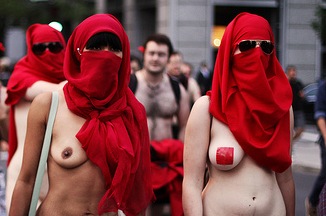Montreal’s student protesters have put down their signs and are taking something of a break until classes resume in August. Meanwhile, there is time to examine the movement against tuition hikes and the methods it used to draw local and international support.
One of the most attention-grabbing tactics of the student movement is its use of nudity, specifically topless women. There were many “nude” student protests over the months, the most notable during the Montreal Grand Prix.
Yanick Grégoire is the executive vice-president of Fédération étudiante universitaire du Québec — one of the associations behind the student movement. He says the nearly-nude marches are symbolic on three levels. First of all, by removing their clothes the students are suggesting they would have to “sell their shirts” in order to afford tuition hikes. Simultaneously, the nudity also represents the lack of transparency in the Quebec government and university administration. Finally, going nearly-nude is a response to the government’s attempts to demonize students because it helps “remind people that students are humans,” Grégoire explains.
But people like writer Naomi Lakritz are not convinced toplessness is an effective way to draw support to a cause. “I really don’t understand the connection between disrobing … and protesting. It seems to me that when you parade around naked in public, you sacrifice your personal dignity — and the dignity of your cause gets sacrificed along with it,” she wrote in a column for the Calgary Herald.
Later, she adds: “If they didn’t need nudity to get their point across nearly 50 years ago at the Lincoln Memorial, at Tiananmen Square in 1989, during the Prague Spring of 1968, or even during John Lennon’s and Yoko Ono’s bed-in for peace, they certainly don’t need it now,” she argues.
Despite Lakritz’s views, toplessness and protesting have crossed paths throughout history.
As illustrated in the accompanying graphic, Canada has a long history of female toplessness as a form of protest. In the 1990s, Gwen Jacob pioneered a battle with Canada’s courts over women’s right to go topfree. Today, activist groups use toplessness and nudity to protest everything from the fur industry to consumerism.
Given the history of the female body as a space colonized by patriarchy, the concept of the topless protesters carries many connotations. In one sense, a women may be empowering herself through the shedding of clothing. At the same time, however, is there a risk to using toplessness as a tool for activism? By exposing their breasts to attract attention, are women supporting the heteronormative culture?
Dr. Paul Rapoport, coordinator of the Topfree Equal Rights Association (TERA), says there is not necessarily a problem with using the female body as a means of protest.
“Women’s bodies are not just a predicament but a resource,” he notes.
He also adds that through exposing their bodies, women may be able to simultaneously take control of their bodies and reclaim them from a history of patriarchy.
The organization GoTopless actively supports female topfreedom and argues women should have the right to go topless wherever men are allowed to do the same. Spokesperson Diane Brisebois says there is nothing wrong with women using their breasts as a tool for protest. “Women who have chosen to … protest topless are simply practicing their right and demonstrating the courage that many others do not have,” explains Brisebois.
If anything, the topless protests have been effective in drawing popular interest. The nude protests were discussed across Canada, from the National Post to CBC.ca and Yahoo News.
“Of course women’s breasts can attract some kind of attention,” Grégoire admits, but, he adds, “The goal is to use symbolism to protest the tuition fee hike and not only to show breasts.”
Yet despite being a creative way of drawing attention to the student movement, protesting topless carries a range of connotations, and they are not always positive.
Many of the topless female protesters covered their nipples with red squares — the symbol of the student movement. TERA’s blog criticizes the act, saying it “projects a mixed message.”
Rapoport explains the red patches may suggest fear or shame. “They say ‘we’re exposing our breasts, but we’re not,” he notes. He also suggests the red patches may draw extra attention to the breasts, making the protest more “carnivalesque” or “erotic” than intended.
In the case of Gwen Jacob, who as a 19-year-old removed her shirt on a hot summer day in Guelph back in 1991, the Ontario Court of Appeal ruled Jacob was not performing a sexual act by simply exposing her breasts, given the context. Despite this landmark ruling, toplessness continues to be mixed with connotations of sexuality in Canada.
Even as a female writer, Lakritz insists: “If you don’t want to be seen as a commodity, and you want people to accept you as a person with dignity, the last thing you should do is undress like you’re a commodity.”
Historically, women have not always agreed on feminist values, and topfreedom is no different. Even the right to vote was not supported by all women at first. “Many women were frowned upon for wanting to have a say in politics,” Brisebois notes.
Despite mixed messages and diverse opinions on topless protests, nearly-nude students seem to have effectively drawn attention to their cause. Just as they have liberated themselves of their clothing, perhaps students will be able to liberate themselves from the increasing costs of tuition.
Jaela Bernstien is a contributing editor for rabble.ca. She graduated with Honors from Western University, where she also worked as managing editor for the Western Gazette. Now she lives in Montreal and freelances as a writer, editor and graphic designer.




